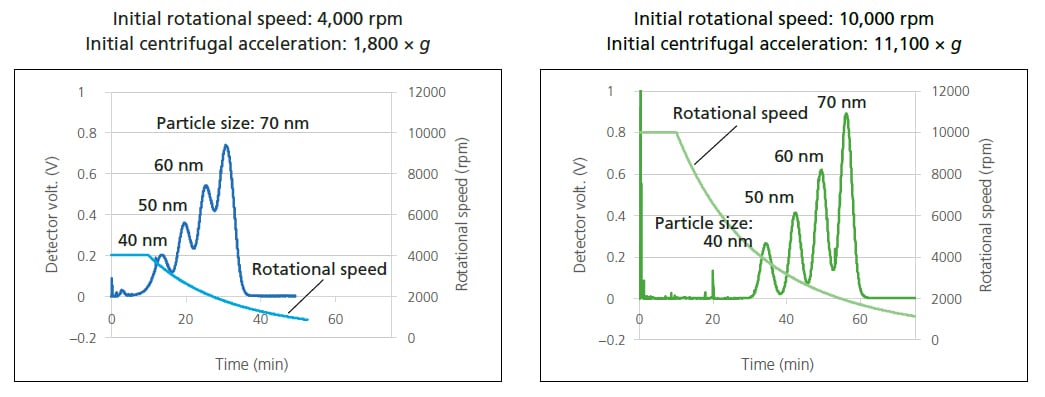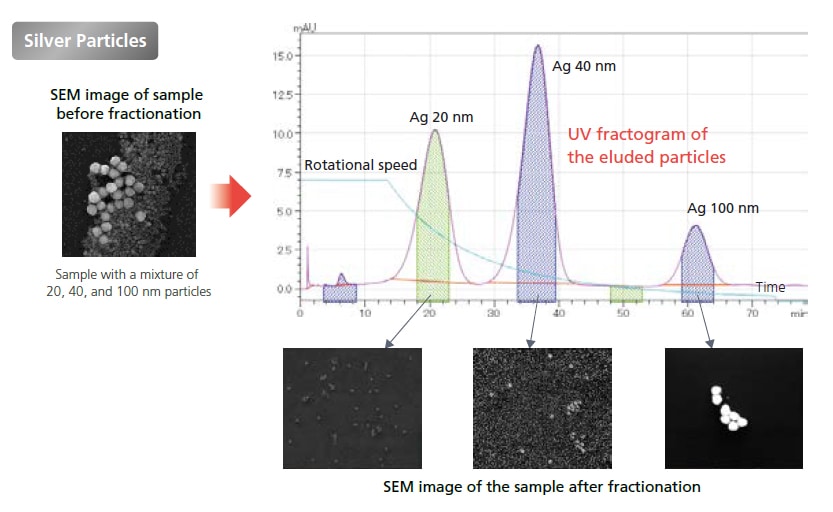CF3-C8030 - Centrifugal Field-Flow Fractionation Unit - Features
Centrifugal Field-Flow Fractionation Unit
Widest Range of Particle Sizes
Online Measurement of Separated Particles
Accurately characterizing samples with a wide range of particle sizes is a significant challenge for traditional methods. With transmission electron microscopy (TEM), smaller particles are often obscured by larger ones, leading to inaccurate size and count data, while its narrow field of view requires time-consuming analysis of multiple images to build a complete distribution. Similarly, with dynamic light scattering (DLS), larger particles have more weight on the results than the smaller ones, preventing accurate measurement. Centrifugal Field-Flow Fractionation (CF3) overcomes these limitations by physically separating particles before the measurement is performed. This approach allows each particle population to be analyzed independently and without interference. The result is a high-resolution, accurate measurement of the true particle size distribution for every population within your sample.

Note: The TEM image was taken at the Consortium for Measurement Solutions for Industrial Use of Nanomaterials (COMS-NANO).

Simultaneous Separation of a Wide Range of Particle Sizes
Compared to size exclusion chromatography (SEC) and hydrodynamic chromatography (HDC), CF3 can separate particles of a wider range of sizes, making it suitable for simultaneous measurement of samples containing a mixture of particles with widely varying particle sizes.

Highest Resolution
High Separation Performance With a Maximum Centrifugal Force of 15,900 x g
Maximizing Resolution
Resolution can be improved by applying a higher RCF. The figure below shows an example of analysis of a mixed sample of silica particles with particle sizes of 40 nm, 50 nm, 60 nm, and 70 nm at initial RCFs of 1,800 x g and 11,100 x g. It can be seen that increasing the initial RCF improves resolution.
*This data was measured by the Consortium for Development of Measurement Solutions to Support the Industrial Use of Nanomaterials (COMS-NANO).

Superior Separation and Analysis of Smaller Particles
Applying a higher centrifugal force makes it possible to analyze smaller particles. The data here shows that when silver particles containing impurities (particle diameters of 10 nm and 40 nm) are analyzed at an initial centrifugal acceleration of 2,300 × g, it is not possible to separate the impurities from the 10 nm silver nanoparticles. However, by increasing the initial centrifugal acceleration to 14,000 × g, the impurities are easily separated from the 10 nm silver particles.

Flexible Combination with Various Techniques
Analysis of Silver Nanoparticles

SEM Image of the Sample After Classification
The separated particles can be analyzed online using an LC detector such as an UV-VIS detector, and then particle size can be measured using techniques such as a multi-angle light scattering detector (MALS) or SEM observation of the fractionated particles.
*This data was measured by the Consortium for Development of Measurement Solutions to Support the Industrial Use of Nanomaterials (COMS-NANO).


